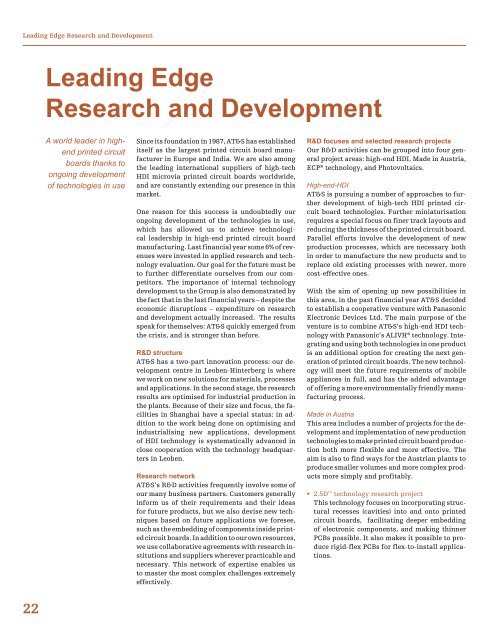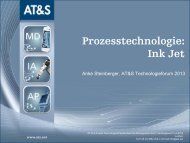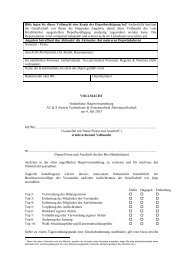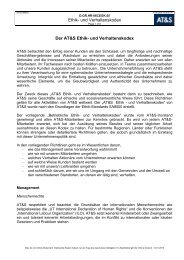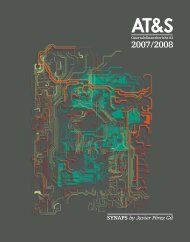AT&S World
AT&S World
AT&S World
You also want an ePaper? Increase the reach of your titles
YUMPU automatically turns print PDFs into web optimized ePapers that Google loves.
Leading Edge Research and Development<br />
22<br />
Leading Edge<br />
Research and Development<br />
A world leader in highend<br />
printed circuit<br />
boards thanks to<br />
ongoing development<br />
of technologies in use<br />
Since its foundation in 1987, AT&S has established<br />
itself as the largest printed circuit board manufacturer<br />
in Europe and India. We are also among<br />
the leading international suppliers of high-tech<br />
HDI microvia printed circuit boards worldwide,<br />
and are constantly extending our presence in this<br />
market.<br />
One reason for this success is undoubtedly our<br />
ongoing development of the technologies in use,<br />
which has allowed us to achieve technological<br />
leadership in high-end printed circuit board<br />
manufacturing. Last financial year some 6% of revenues<br />
were invested in applied research and technology<br />
evaluation. Our goal for the future must be<br />
to further differentiate ourselves from our competitors.<br />
The importance of internal technology<br />
development to the Group is also demonstrated by<br />
the fact that in the last financial years – despite the<br />
economic disruptions – expenditure on research<br />
and development actually increased. The results<br />
speak for themselves: AT&S quickly emerged from<br />
the crisis, and is stronger than before.<br />
R&D structure<br />
AT&S has a two-part innovation process: our development<br />
centre in Leoben-Hinterberg is where<br />
we work on new solutions for materials, processes<br />
and applications. In the second stage, the research<br />
results are optimised for industrial production in<br />
the plants. Because of their size and focus, the facilities<br />
in Shanghai have a special status: in addition<br />
to the work being done on optimising and<br />
industrialising new applications, development<br />
of HDI technology is systematically advanced in<br />
close cooperation with the technology headquarters<br />
in Leoben.<br />
Research network<br />
AT&S’s R&D activities frequently involve some of<br />
our many business partners. Customers generally<br />
inform us of their requirements and their ideas<br />
for future products, but we also devise new techniques<br />
based on future applications we foresee,<br />
such as the embedding of components inside printed<br />
circuit boards. In addition to our own resources,<br />
we use collaborative agreements with research institutions<br />
and suppliers wherever practicable and<br />
necessary. This network of expertise enables us<br />
to master the most complex challenges extremely<br />
effectively.<br />
R&D focuses and selected research projects<br />
Our R&D activities can be grouped into four general<br />
project areas: high-end HDI, Made in Austria,<br />
ECP ® technology, and Photovoltaics.<br />
High-end-HDI<br />
AT&S is pursuing a number of approaches to further<br />
development of high-tech HDI printed circuit<br />
board technologies. Further miniaturisation<br />
requires a special focus on finer track layouts and<br />
reducing the thickness of the printed circuit board.<br />
Parallel efforts involve the development of new<br />
production processes, which are necessary both<br />
in order to manufacture the new products and to<br />
replace old existing processes with newer, more<br />
cost-effective ones.<br />
With the aim of opening up new possibilities in<br />
this area, in the past financial year AT&S decided<br />
to establish a cooperative venture with Panasonic<br />
Electronic Devices Ltd. The main purpose of the<br />
venture is to combine AT&S’s high-end HDI technology<br />
with Panasonic’s ALIVH ® technology. Integrating<br />
and using both technologies in one product<br />
is an additional option for creating the next generation<br />
of printed circuit boards. The new technology<br />
will meet the future requirements of mobile<br />
appliances in full, and has the added advantage<br />
of offering a more environmentally friendly manufacturing<br />
process.<br />
Made in Austria<br />
This area includes a number of projects for the development<br />
and implementation of new production<br />
technologies to make printed circuit board production<br />
both more flexible and more effective. The<br />
aim is also to find ways for the Austrian plants to<br />
produce smaller volumes and more complex products<br />
more simply and profitably.<br />
2.5D technology research project<br />
This technology focuses on incorporating structural<br />
recesses (cavities) into and onto printed<br />
circuit boards, facilitating deeper embedding<br />
of electronic components, and making thinner<br />
PCBs possible. It also makes it possible to produce<br />
rigid-flex PCBs for flex-to-install applications.


